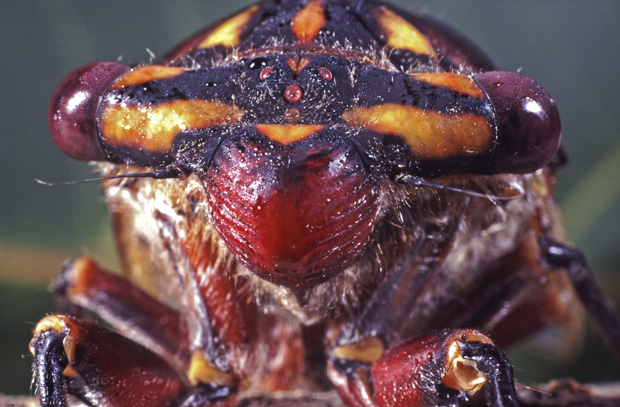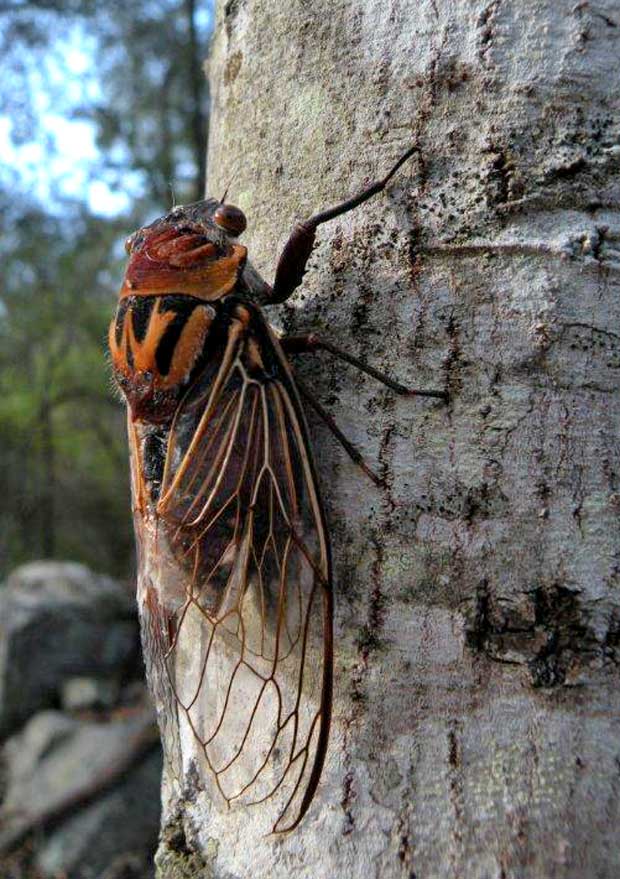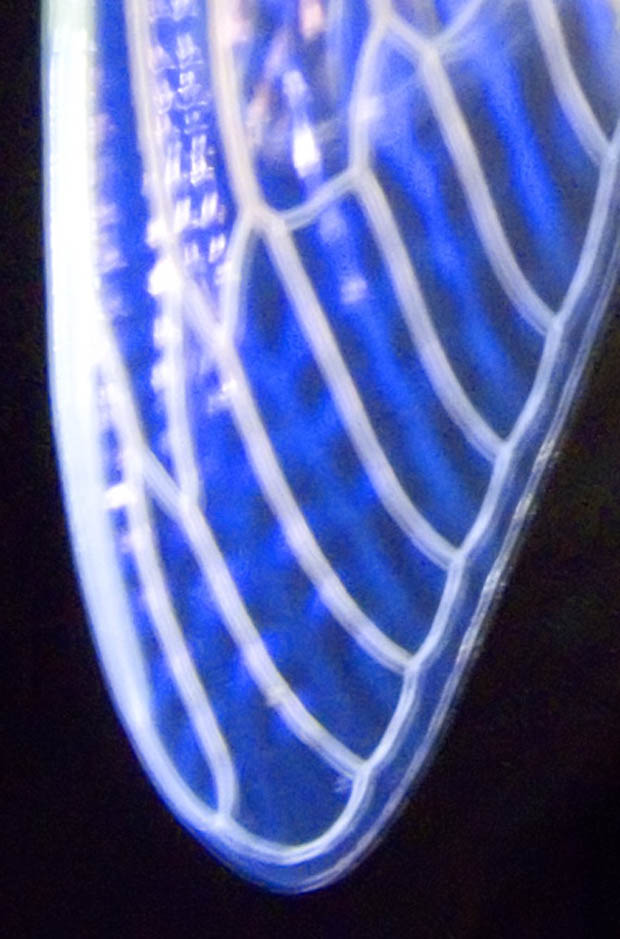
A Cherrynose Cicada (Macrotristria angularis), a spectacular, large Australian cicada. I had to capture this one to photograph it so closely, as the males are exceptionally wary when on trees. Its call is a tinkling and reverberating song. The ‘nose’ is actually a postclypeus, which has nothing to do with breathing — it houses the muscles for the feeding system. Photograph R. Ashdown.
Cicadas are amazing creatures. A long life as an underground-dwelling nymph is followed by a wonderful transformation to adult winged treetop dweller. At the moment the air is alive with the sounds of cicadas. As I write this a Clanger (Psaltoda claripennis) is rattling and clanging away on a jacaranda tree on the footpath. Come twilight, the sound of traffic is completely drowned out by the rumbling drone of the Bladder Cicada (Cystosoma saundersii). In nearby eucalypt woodlands the roar of Razor Grinders, Cherrynoses and Double Drummers is truly overpowering.
These are the loudest insects on the planet. The Green Grocer, Yellow Monday and the Double Drummer produce noise intensity greater than 120dB at close range — a sound approaching the pain threshold of the human ear. A large Razor Grinder in full song can cause permanent hearing loss if held close to the human ear (great idea, eh?).
Entomologist Chris Burwell from the Queensland Museum explains cicada song in Wildlife of Greater Brisbane. Designed to attract females, the song of the male cicada unfortunately alerts predators, particularly birds, to its presence. As a result calling male cicadas usually take flight as soon as you approach them (making them quite hard to photgraph). Calling males often form huge groups, and there is evidence that this ‘wall of noise’ actually repels birds, because it is so painful to their ears!
Their interesting songs, striking appearance and sudden summer arrival (including their mysterious abandoned nymph cases) has brought these harmless insects lots of fans. As a child I marveled over the images of emerging cicadas by the astonishing Densey Clyne, and as a photographer always enjoyed trying to capture them on film – which can be quite challenging. Photographing the emergence of adults from the nymph stage is always fun. This happens under cover of night (although some species will emerge during the day).
While walking at Ravensboune National Park recently we stumbled upon this emerging adult cicada. After watching it for a while we concluded that it was stuck, and had been so for a few hours. Putting aside my ‘don’t interfere with nature’ rule for a moment, I moved the insect up so that it could grab the branch. Over the next 20 minutes we were transfixed by the entire process — with unfolding wings and the changing body colour, a fascinating transformation.

While walking at Ravensbourne National Park we came across this large emerging cicada. After watching it struggle without result for a fair while we concluded that it was completely stuck, so we intervened, carefully tilting it up so that it could grab the trunk. Photograph R. Ashdown.

Within ten minutes the cicada’s wings were unfolding and its body colour was changing. This is the third and final stage of the cicada’s life. After emerging from an egg, the nymph climbs down to the soil and spends six or seven years underground. Cicada expert Dr Max Moulds has said that their underground sojourn can take anything from nine months to 17 years or more depending on the species. Photo R. Ashdown.

The cicada’s wings are unfolding as fluid is pumped through the veins. The delicate structures will need to harden before flight can be successful. It is usually several days before the cicada starts singing. Photo R. Ashdown.

The wings are moving with the breeze. By the next day I hope it was joining the raucous and joyful chorus with its mates — such an Australian bush sound. Photo R. Ashdown.

Ecologist Greg Ford has just sent me this wonderful image of an adult Double Drummer (Thopha saccata), photographed at Crows Nest National Park. I’d hazard a guess that our young cicada is one of these — the patterns certainly match, and its colour would have darkened during the day. Photograph courtesy Greg Ford.

Another place, another stunning cicada. This nymph has emerged during rain at Amity, on Stradbroke Island, using a verandah railing as the perfect emergence spot. I back-lit this one with a torch to bring out the delicate wing details. Photo R. Ashdown.
For lots of information about cicadas, see the wonderful web work of Lindsay Popple.
Here are some other great links for information about cicadas:

